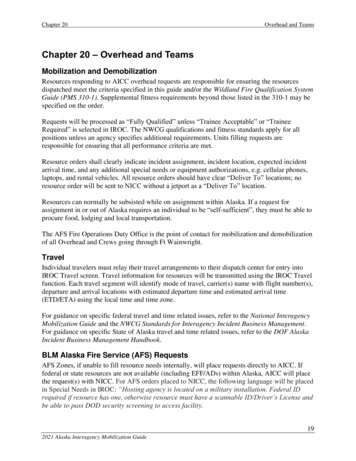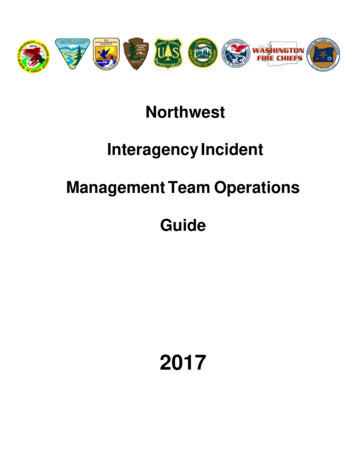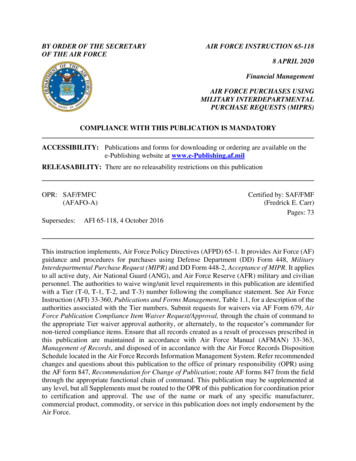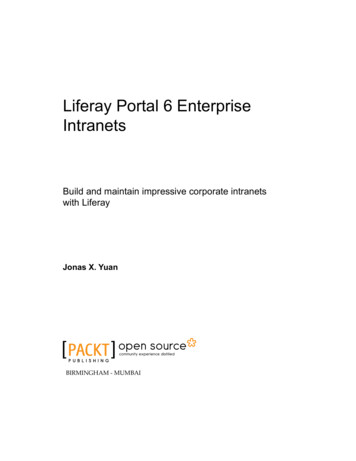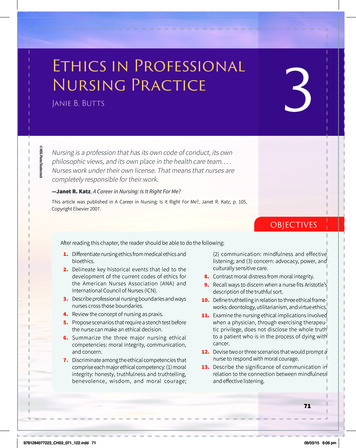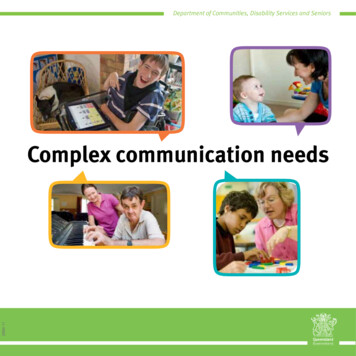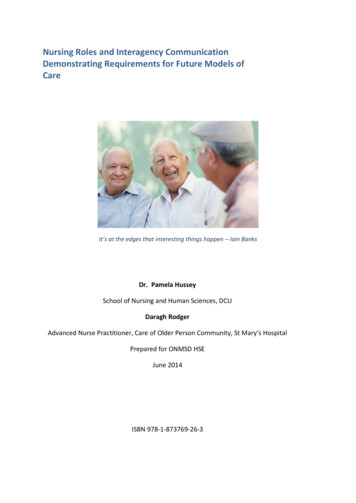
Transcription
Nursing Roles and Interagency CommunicationDemonstrating Requirements for Future Models ofCareIt’s at the edges that interesting things happen – Iain BanksDr. Pamela HusseySchool of Nursing and Human Sciences, DCUDaragh RodgerAdvanced Nurse Practitioner, Care of Older Person Community, St Mary’s HospitalPrepared for ONMSD HSEJune 2014ISBN 978-1-873769-26-3
PARTNERS Version 2Other contributors Deirdre Carroll, Community Interventions Team Nurse HSEKathryn Carroll, Partnership Nurse HSEMary Roach, Community Liaison Nurse MMUHTracy Keating, Community Liaison Nurse MMUHCiara Dowling, Clinical Nurse Manager 3 MMUHElaine Dunne, Clinical Case Manager HSESuzanne Brown, Assistant Nurse Coordinator Computer Services MMUHDr Damon Berry, Health Informatics Dublin Institute of TechnologyMs Gaye Stephens, Health Informatics TCDMr Peter Connolly, HSEMs Anne Spencer PETAL1
PARTNERS Version 2Use Case 1 Nursing Interagency Communication DemonstratingRequirements for Subject Area Models1 IntroductionPatient outcomes including patient mortality are increasingly linked in the evidence base tonursing interventions particularly in the acute care sector [1, 2, 3]. Theories supportingnursing interventions as a critical resource in maintaining optimum health outcomes in thecommunity are also prevalent in the evidence base [4, 5]. Examples include SymptomManagement and Medication Management both of which have been strongly linked toindividuals maintaining independence [6].To date, nursing as the largest professional group within healthcare is recognised as a criticalresource in maintaining population health at an optimum [7]. As society embarks on makingscheduled eHealth models of care a reality, it is time for nursing in Ireland to reflect uponbest approaches which deliver tactical outputs. From an informatics perspective theprofession of nursing engages in a dual role, caring for individuals both as independentpractitioners as well as actively engaging as a member of the co-ordinated multi-disciplinaryteam [8]. This would suggest that both the aforementioned nursing roles (as opposed to solelythe later) require careful consideration. Emerging eHealth models often promoted aspromising citizens core benefits include personal independence , consumer choice, andcitizen empowerment are now scheduled for implementation in Irish policy and strategicplans [9,10] , however recent deployments in other countries have proved challenging [11].Healthcare in Ireland has recently been described as entering into the largest transitionprogramme since the founding of the Irish state [12]. Departing from the existing traditionalmodels of care , the concept of health and healthcare in Irish society will transition from onewhere citizens are viewed as passive recipients of care, to one which actively empowersindividuals to contribute to decisions made in partnership with health care providers.Individualised health care planning and maintenance will be firmly under the control of thecitizen who will have access to (and potentially contribute to) the individual health recordelectronically.This poses a number of questions for nursing leaders in Ireland. How will nursing in Irelandcontribute to the deployment of the emerging eHealth models of care in society? How willnursing protect what is already in existence, what is known to work well and what practicesneed careful revision? What will happen if nursing practitioners fail to recognise their uniqueand critically important position in the scheduled transformation programme? Such questionsare now under careful consideration with nurse leaders not only in Ireland but also globally,particularly in the informatics community [13, 14, 15].Systematic reviews on uptake and use of Electronic Health Records in the United States alsoreport diverse opinions from clinicians which have led to incentivising one example being thenotion of meaningful use [16].2
PARTNERS Version 2As a profession nursing considers electronic health records as both a barrier and facilitator.Key issues reported include increased time interacting with eHealth systems which decreasestheir job performance particularly in regard to patient contact time . Nurses do howeverindicate that electronic health records can and do improve workplace productivity [17].Consistently what is reported within the evidence base is that careful attention to initialdesign briefs and technical issues are important. [18, 19]. Healthcare professionals in a recentreview which included nurses reporting on factors relating to uptake and use of eHealthrecords suggest that 1) design or technical issues 2) perceived usefulness by individual usersand 3) the adopted managerial approaches are significant factors worthy of focusedreflection. The paper also contends that “top down” managerial approaches need to bemediated in tandem with “bottom up” approaches to foster enthusiasm dedication andcommitment for successful implementation processes to occur [18 p.6].In Ireland (and from a HISINM perspective) nursing would argue that the dual role that theprofession provides is often under recognised [20]. Making visible this dual role particularlyin regard to nurse to nurse communication across and between services will be challengingparticularly in the early stages of design and analysis. The timing for design and analysis ofcare practices is imminent particularly before deployment of phase one of Electronic HealthRecord enters procurement stage. Thus ensuring that the often poorly noticed and uniquecontribution which the nursing profession provides that we know has a direct bearing onpatient outcome can achieve optimal recognition and promotion.Whilst the international nursing community contemplates if and how advocacy andcompassion can be articulated in computing terms (Logical or Boolean) this short reportoffers a small and simple case example for further discussion with relevant stakeholders.2. Case Study PARTNERS COP 2This use case is presented as a summary paper for discussion with key stakeholders in HealthServices Executive in Ireland. It provides evidence of the specific uniqueness that nursingprovides in one area in Dublin North and demonstrates how the profession manages nurse tonurse and nurse to MDT inter agency communication to support front line care to olderpersons. This use case could have been articulated from a number of perspectives howeverthis group have chosen to consider the journey from the perspective of an older personsdischarge from acute services and the subsequent issues that arose which are for the main partmanaged by nurses to avoid hospital readmission. The choice of older person services andreadmission is deliberate and specific as this particular group are listed in HSE service planas Key Performance Indicators for national Clinical Programmes in Specialist GeriatricServices Model of Care. [21]. This use case forms part of a phased approach to articulatingthe nursing contribution to eHealth Ireland. It presents material for potential use as part of aSubject Area Model for nursing and midwifery practice. Currently Subject Area Models arein development within the HSE as part of the Integrated Services Framework agenda. Thecore objective of the Integrated Services Framework is to develop a national standards basedframework which will ensure that key systems and components can share information (data)3
PARTNERS Version 2in a timely and organised fashion. Briefly, a Subject Area Model is an abstract representationof a topic (in this particular case nursing practice) developed in partnership with practitionerswho have a clear understanding of the domain. The Subject Area Model can be used toexpress information requirements (data sets) to multiple stakeholders for clinicalcollaboration. This subject area model is used in tandem with a computer software constructentitled a Reference Model collectively the Subject Area Model and Reference Modelprovide the core platform which allows computers to transfer information across and betweenservices and display the information appropriately to clinicians. The platform defined withinthe Integrated Services Framework is demonstrated in Appendix 1.Seven nurses engaged within the team over a two month period and met twice. Five of thenursing roles are articulated in the scenario as there was overlap with some of the rolesdepicted. It is worthwhile noting that the nursing participants crossed a number of servicesand were not clustered as employed in one single service. We therefore would like to thankthe respective management for their co-operation in this particular initiative, andacknowledge the proactive approach adopted to provide the information to complete thisprocess which was carried out independently from any funding agency.The aim of this use case is to: Demonstrate the unique contribution that nursing services make in inter agencycommunication in Ireland in regard to nurse to nurse and nurse to MDT Role.Explore the need to engage with the development of a Subject Area Model forNursing and Midwifery services within the HSE Integrated Services FrameworkProgramme from a national perspective.Identify within HSE ICT a nursing and midwifery profile for future procurementrecognising the dual role that contemporary nursing and midwifery provides inaccordance with recently published DoH eHealth and HSE ICT Strategy (EU andWHO Nursing Division).The objectives of this use case are to:a) Provide subject material to justify resource use on a dedicated Subject Area Modelfor nursing and midwifery in Ireland.b) Improve the impact and cost effectiveness of eHealth Strategy with a validatedSubject Area Model which relates to nursing care and older person services.c) Inform and adopt the uptake of profiles for eHealth standards development inIreland in accordance with the HSE ICT Strategy and EU CEN TC 215 WorkingGroup 1.The paper is presented as follows: Brief Introductory Section on Nursing Roles and scope of this document Use Case Scenario and Figures 1-5 demonstrating care workflow4
PARTNERS Version 2Nursing RolesIn this Use Case a specific area of nursing care and communication is focused on. Theemphasis is on nursing services which cross the acute and primary care domains. It istherefore important to note that this scenario deals solely with one core dimension of practiceoffering a view of interagency communication between the nurses identified in older personsservices. It is also based on one region in HSE Dublin North. As a Use Case it does not detailthe many additional roles carried out in the acute and primary care services such as ClinicalNurse Specialist, Registered Acute and Community Nurses and Public Health Nurses orindeed the expanding role of the practice nurses in private practice. The recent digiPHITproject has developed a strong business case for future module deployment for Public HealthNursing and it is envisaged that any future subject area model will be linked with thisresource.Five distinct nursing roles are identified in this Use Case Scenario in Dublin North. Theyinclude the following; Community Interventions Team Nurse Partnership Nurse Community Liaison Nurse/Clinical Case Manager Clinical Nurse Manager 3 Advanced Nurse Practitioner RoleThe scenario described in section three identifies the role of the Community Liaison Nurse(Day 24). On review of the interventions completed in this role, it is recognised that there issome overlap with the role of the Clinical Case Manager however the Clinical Case ManagerRole is distinguished from the Community Liaison Nurse in that it offers a consult servicewhich includes liaison with mangers of older persons for community services. The ClinicalCase Manager role crosses traditional service boundaries working with community serviceson sourcing solutions on complicated cases. Whilst this distinction exists in practice, for thepurpose of the collectively defined use case scenario a decision was made not to duplicatethis role in this report.1. Advantages of Inter agency communication across and between agencies inUse Case are considered as follows.a) Early detection of health issues that require nursing interventions or referral toMDT e.g. Blood pressure monitoring (Partnership Nurse )5
PARTNERS Version 2b) Early detection of social issues that may impede maintenance or enhancedpatient outcomes (Community Interventions Team).c) Reduce length of stay in acute service (Community Liaison Nurse )d) Reduce readmission by early detection of health and social care issues(Advanced Nurse Practitioner)e) Effective Medication Prescribing /Adjustment management (R.N.P)f) Effective Symptom Management (All practitioners)g) Effective Patient education (All practitioners)h) Effective Patient advocacy (All practitioners)i) Enhances Inter agency communication ,continuity of care across and betweenservices ( All practitioners)2. PARTNERS Use CaseIntroductionDischarge and discharge follow up of elderly patients requires focused interagencycommunication. Typically this inter agency communication is both formal andinformal and involves engagement across and with different service providersincluding different consultant specialists, general practitioners, hospitals, pharmacistsfamilies and carers.Different information is required at different times in order to manage the individualcase for example booking appointments and offering a summary view of thescheduled itinerary process. In this Use Case scenario nursing management of theinteragency care process is provided illustrating timely access to information for keystakeholders involved in the health care process of discharge and discharge follow up.Purpose and Scope Referral in to review and complete assessmentReferral out to link to relevant health care professional for follow upReview and repeat assessmentTracking of relevant events as scheduled on itinerary e.g each subtask in theworkflow scheduleMedication management – Prescription create , Prescription review of existingprescription for poly pharmacy interactionLinking created documents to relevant stakeholders in contextIn this use case the workflow (Figures 4.3 to 4.7) demonstrates the cross enterprise setting inwhich the nursing roles 1-5 practice interventions in Dublin North.6
PARTNERS Version 2StoryboardJoe Brown is a 78 year old single man who lives alone. He is not known to Public HealthNurse and is not in receipt of any community supports. He has a medical history of chronicobstructive pulmonary disease (COPD).Day 1: Joe Brown presents to Accident and Emergency Department (A&E) with ahistory of being unwell x 5 days with deteriorating conditionKnown COPD diagnosed with chest infection and required IV antibiotics initiated in A&E.referred to Out Patient Anti-biotic Team (OPAT), CIT Nurse Initial Review Antibiotic 1stdose is initiated by A&E Dr, prescription given to the nurse and Joe is transferred homeInformation Flow – Discharge Pathway Documented Plan, Prescription management, ReferralDocumentation, Next of Kin Contact with Appointment Schedule Date and to co-ordinate travelarrangements to home environment, CIT Assessment InitiatedDay 3: OPAT Refers Joe to CIT (1) for IV antibiotic home therapyIV antibiotics administered over 5 days at home by CIT service. Follow up in outpatients byhospital team arranged with OPAT team.Education and advice given by CIT nurse to Joe on the management and correct use of hisinhalers. Joe discharged from CIT service and report sent to General Practitioner , ReferringOPAT team and Public Health Nurse to alert of recent episode.Information Flow – First Assessment Completed, Care Plan – Key areas included education ofDay8: Dischargefrom Serviceno interventionsbetween Day8 andReportsDay 201.*medicaldevices, symptommanagementfatigue breathlessness,SummaryDay 21: Joe visits his GP – history of dizziness. GP refers Joe Brown to PartnershipNurse (PN) (2) for Blood Pressure monitor to out rule postural hypotension and forhome assessment prior to Geriatrician outpatient appointmentDizziness on three separate occasions reported and one incident in which Joe nearly fell.Partnership Nurse contacted Joe and home visit arranged.Information Flow – GP Assessment Referral to Partnership NurseDay 24 Partnership Nurse visits Joe at homeOn arrival at the home Joe was found to be unwell, shortness of breath and wheezy, knownCOPD, inhalers ineffective and offered little or no relief to symptoms. Joe quite distressedand following assessment was referred to A&E by Partnership Nurse.Information Flow – Partnership Nurse 1st Assessment Referral to A&EDay 24: Patient Joe Brown presents to A&EImpression – exacerbation of COPD and is admitted to a ward.7
PARTNERS Version 2Information Flow – Acute Service EMR: ADT System AE System Order Communications ClinicalDocumentationDay 24: Referred to Community Liaison Nurse (3) to notify of admissionDuring course of admission identified need for increased care supports at home. To ensuresafe discharge recommended transfer to transitional care once medically stable. Referrals sentto social worker re Home Care Package and Public Health Nurse regarding transfer totransitional care.Information Flow – Review of existing documentation in EMR in acute trust, Referral to MedicalSocial Worker, PHN and Discharge Plan for Transitional Care UnitNB this role is also reflected as Clinical Case Manager in Connolly HospitalDay 35: Referral sent to Synge unit CNM III (4)Assessed on admission to unit and care needs identified care plan commenced. Length ofexpected stay is 14 days. Prior to discharge liaison with PHN re admission, HCP andnebuliser and need for ongoing support from community services. On discharge homeappointment given for follow up in Medicine for the Elderly services in St Mary’s. Ongoingcommunication by phone with Joe to ensure discharge plan is working.Information Flow – Clinical Documentation Assessment 1.* Referral Documentation to MDT andPHN Discharge Plan includes Appointment to Geriatric Services Mobile Communication by PhoneAssessment and reassessment and daily reviews of progress while inpatient end of careepisode discharged from Synge service Day 50.Day 58 CNMIII (4) Contact Joe by mobile phone re appointment in Day Hospital.Day 60: Appointment in Day Hospital in St Mary’sTo be seen by Geriatrician for follow up post recent admission to hospital. Joe did not attendappointment. He was contacted by nurse in Day Hospital and stated he was unable to travel.Concerns raised in regard to his progress since discharge from hospital Referral to ANP tocarry out home assessment.Information Flow – Mobile Communication by Phone EmailDay 61: Advanced Nurse Practitioner Older Persons (5)Contacted Joe and arranged home visit for next day.Information Flow – Mobile Communication by Phone8
PARTNERS Version 2Day 62: Home assessment carried out.Revealed recent fall sustained by Joe query cause of incident. Joe is a poor historian fallincident requires further investigation and to rule out blackout, mobility reduced no apparentinjury. Plan to refer to St Mary’s falls clinic for geriatrician – further investigation of fall ruleout syncope postural hypotension – tilt table and finometry, for physiotherapy assessment gait assessment & enrol community falls physiotherapy class . Liaise with PHN to informof recent fall, liaise with carers to monitor falls risk. Liaise with transport to collect and bringto appointment in St Mary’sInformation Flow – First assessment - referral to falls clinic - Geriatrician & Physiotherapy,Liaise communication with Public Health Nurse and Carers Book Transport for service reviewDay 75: Transport arranged to collect Joe and bring him to falls clinic in St Mary’s.Nursing assessment by Day Hospital nurse, medical assessment by Geriatrician, mobilityassessment by physiotherapy, referral sent for DXA scan for bone health assessmentInformation Flow – Second assessment with referral to fall clinic. Order Communications DXAClinical Notes 1.* in Day Hospital 10 weeksJourney of care continues for Joe. He will continue to live at home with ongoingassessments, interventions, support and education from the community nursing team.Journey includes the following services on this use case scenarioA&E - CIT - GP - PN – A&E – CLN – CNMIII – DH – ANP – DHFigure 4.1 offers a summary diagram of the Nursing Actors engaged in the management ofJoe Browns Use Case of care provision.9
PARTNERS Version 2Figure 4.1 Continuity of Care Subject Joe BrownIn Figure 4.2 a list of transactions across and between the acute and primary care services areincluded to request service access input view and edit the summary records of the use casewith the relevant hardware resources . It is anticipated that a patient access portal will also beavailable as per eHealth strategy (2013)10
PARTNERS Version 2Figure 4.2 Process FlowThe five nurses’ key inputs processes and outputs are summarised in the following data flowcharts.11
PARTNERS Version 2Figure 4.3 Community Liaison Nurse 112
PARTNERS Version 2Figure 4.4. Community Interventions Team13
PARTNERS Version 2Figure 4.5 Partnership Nurse14
PARTNERS Version 2Figure 4.6 Advanced Nurse Practitioner15
PARTNERS Version 2Figure 4.7 Clinical Nurse Manager III16
PARTNERS Version 2ConclusionThis short Use Case Report describes the complexity of inter-agency communication thatnurses engage with in addressing health and social care issues of older adults in one particularregion of Dublin North. It highlights the dual role that nursing engages with bothindependently and as part of a co-ordinated multi-disciplinary team. Future design andtechnology requirement specifications will be required to be cognisant of the dual role thatnursing plays in health service provision. Determining what is core and what is unique fromthe wide range of services and experiences that nursing provides is critical for successfulprocurement and deployment of eHealth systems. Failing to engage on the design brief forfuture Electronic Health Records may result in poorly designed software which fails todeliver not only appropriate evidence on critical health issues , wellness and individual healthand social care , but also to safeguard the often subtle but critical role that nursing provides inIreland. It is at the edges (of health care provision) that interesting things happen.17
PARTNERS Version 2References1. Aiken L, Scott PA Nurse Staffing and Education and Hospital Mortality in 9 EuropeanCountries. A Retrospective Observational Study. EU Programme RN4Cast The Lancet 20142. McGillis Hall L, Wodchis WP , Ma X, Johnson S Changes in patient health outcomes fromadmission to discharge in acute care Journal of Nursing Care Quality 2012, 28(1):8-163. Woodchis WP , Ma ,X, Simeonvov, D, Stamplecoski, M. White P , Purdy,I , Jeffs, L, Iron K,De Nobrrega, P. McGillis Hall , L Health Outcomes for Better Information and Care(HOBIC) : Actue Care in Ontario 2012 ICES Report Online Resource Available s/2013/HOBIC-2012 Accessed 1stFebruary 20144. McDonald A , Population Health Information Tool HSE Report Online Resource Availablefrom http://www.lenus.ie/hse/handle/10147/213010 Accessed 12th April 20145. Population Health Interest Group: McDonald A. Duignan C. Healy M.Irving A. MartienssonP. Molloy B. McNicholas E. Frazer K. Public Health Nursing in Ireland: demonstratinginterventions from practice-validating public health nursing actions using the AmericanIntervention Wheel Online Resource Available fromhttp://www.lenus.ie/hse/handle/10147/315652 Accessed April 17th 20146. Almost J, Doran D, McGillis Hall L, 2003. Nursing Sensitive Outcomes State of the Science.Toronto Canada: Jones and Barlett.7. McDonald A Institute of Community Health Nursing DigiPHIT Report Online ResourceAvailable from http://www.ichn.ie/ichn-resources Accessed April 17th 20148. Hovenga E J S, Kidd M, Garde S (2nd Ed) 2010 Health Informatics: An overview IOS PressAmsterdam9. Department of Health and Children eHealth Strategy for Ireland Online Resource Availablefrom www.dohc.ie/publications/eHealth Strategy 2013.html Accessed 2nd April 201410. HSE ICT Strategic Development Group HSE ICT Strategy 2014 (Draft Copy Review)11. Greenhalgh T, Russell, J. Ashcroft RE, Parsons W Why National eHealth Programs NeedDead Philosophers: Wittgensteinian Reflections on Policymakers' Reluctance to Learn TheMillbank Quarterly Vol 89 No 4 2011 pp 533-56312. McLoughlin A, Role of Technology in the Reform of Health Services Back to the FutureNursing and Midwifery Board of Ireland National Conference 15th October 2013 DublinOnline Resource Available from http://www.nursingboard.ie/en/news conferences.aspxAccessed 14th April 201413. Foster , J. Nursing Informatics and eHealth in Australia In An Introdution to NursingInformatics 4th Edition 2014 Springer14. Proctor, P Nursing Education In An Introduction to Nursing Informatics 4th Edtion 2014Springer18
PARTNERS Version 215. Hussey P and Kennedy M eHealth a Global Priority In An Introduction to NursingInformatics 4th Edition 2014 Springer16. Blumenthal D , Tavenner M The "Meaningful Use" Regulation for Electronic Health RecordsNew England Journal of Medicine 363,6,501-4 201017. Kossman, SP 2006 Perceptions of Impact of Electronic Health Records on Nurses Work StudHealth Technology Information 2006 122:337-34118. McGinn C.A, Grenier,S. Duplantie, J, Shaw, N, Sicotte, C, Mathieu, L, Leduce, Y, Legare, F.Gagnon MP Comparison of User Groups’ Perspectives of Barriers and Facilitators toImplementing Electronic Health Records : A Systematic Review BMC Medicine 2011, 9-46Online Resource Available from d 2nd April 201419. Greenhalgh,T , Potts, HWW, Wong,G. Bark, P. Swingglehurst, D Tensions and Paradoxes inElectronic Patient Record Research : A Systematic Literature Review Using the Meta –narrative method Millbank Quarterly 2009, 87(4): 729-78820. Health Informatics Society of Ireland Nursing and Midwifery Group Online ResourceAvailable from http://www.hisinm.ie Accessed 8th April 201421. Specialist Geriatric Services Model of Care Part 1Acute Service Provision Version 1.0 HSE,RCPI, 2012 National Clinical Programme for Older People (NCPOP22. Doran D , Haynes B.R, Estabrooks C.A, Kushniruk A ,Dubrowski A, Bajnok I, Hall L MG,Mingyang L, Carryer J, Jedras D, Bai YQC The Role of organisational context and individualcharacteristics in explaining variation in use of information technologies in evidence basedpractice Implementation Science 2012 :723. Harris Bradshaw and Koch The prescription for misunderstanding; opportunities formisinterpretation along the information flow from physician to patient Journal of Educationand Practice 201419
PARTNERS Version 2Appendix 1 Subject Area Models and Integrated Services FrameworkSource Mr Peter Connolly Integrated Services Framework Project Manager HSE20
School of Nursing and Human Sciences, DCU Daragh Rodger Advanced Nurse Practitioner, Care of Older Person Community, St Mary's Hospital Prepared for ONMSD HSE June 2014 ISBN 978-1-873769-26-3 Nursing Roles and Interagency Communication Demonstrating Requirements for Future Models of Care
